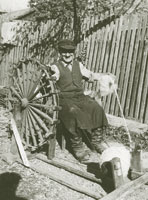Juraj Zajonc
The basis of traditional methods for making yarns is hand-twisting fibres, usually in a clockwise direction. This working method, together with the basic tools, has not changed over thousands of years and is known in all cultures using plant or animal fibres for producing textiles. We can distinguish three methods of making yarn according to the type of yarn processed, tools used, and procedures together with the character of the final yarn. The oldest and most archaic procedure is rolling: fibres are rolled between the hands or by use of the palm on the thigh, calf or cheek. Tools used for rolling were only used for winding the ready yarn, not for rolling it. In other methods for making yarn, fibres were rolled using tools or machines. The basic and oldest types of tools are wooden hooks and various types and sizes of spindles. Spinning was made several times faster by the flyer spinning wheel. In Slovakia, the flyer spinning wheels spread from the 18th century in connection with the developments of manufacturers. Three types of spinning wheels were used in traditional home production (according to the position of the wheel and flyer): upright, sloping and flat-lying spinning wheel.
